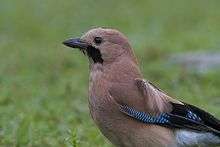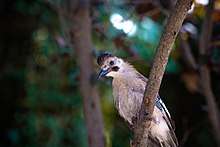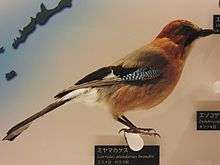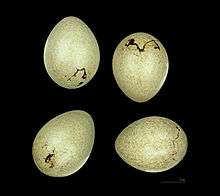Eurasian jay
The Eurasian jay (Garrulus glandarius) is a species of bird occurring over a vast region from Western Europe and north-west Africa to the Indian Subcontinent and further to the eastern seaboard of Asia and down into south-east Asia. Across its vast range, several very distinct racial forms have evolved to look very different from each other, especially when forms at the extremes of its range are compared.
| Eurasian jay | |
|---|---|
 | |
| A Eurasian jay at the Yerevan Botanical Garden, Armenia | |
| Scientific classification | |
| Kingdom: | Animalia |
| Phylum: | Chordata |
| Class: | Aves |
| Order: | Passeriformes |
| Family: | Corvidae |
| Genus: | Garrulus |
| Species: | G. glandarius |
| Binomial name | |
| Garrulus glandarius | |
| Subspecies | |
|
33 (in eight groups) - see text | |
 | |
| Range of G. glandarius | |
| Synonyms | |
|
Corvus glandarius Linnaeus, 1758 | |
The bird is called jay, without any epithets, by English speakers in Great Britain and Ireland.
Taxonomy and systematics

The Eurasian jay was one of the many species originally described by Linnaeus in his 18th century work Systema Naturae. He recognised its affinity with other corvids, naming it Corvus glandarius.[2] The current scientific name is from Latin; Garrulus means noisy or chattering, and glandarius is "of acorns", a favoured food.[3]

Eight racial groups (33 subspecies in total) are recognised by Madge & Burn (1994):[4] Jena Phyletic Museum, in Germany, features an excellent display of plumage variations across these races, which is used as a particularly striking example of the variation that can be found within species.

- the nominate group (nine European races), with a streaked crown.
- the cervicalis group (three races in North Africa), with a rufous nape, grey mantle, very pale head sides, and a streaked or black crown.
- the atricapillus group (four races in Middle East, Crimea & Turkey), with a uniform mantle & nape, black crown and very pale face.
- the race hyrcanus (Caspian Hyrcanian mixed forests of Iran), small with black forecrown and broadly streaked hindcrown.
- the brandtii group (four races in Siberia and northern Japan), with a streaked crown, reddish head, dark iris and grey mantle.
- the leucotis group (two races in south-east Asia), with no white in the wing, a white forecrown, black hindcrown and much white on the sides of the head.
- the bispecularis group (six races in the Himalayan region), with an unstreaked rufous crown, and no white wing-patch.
- the japonicus group (four races in the southern Japanese islands), with a large white wing-patch, blackish face and scaled crown.
Distribution and habitat
A member of the widespread jay group, and about the size of the jackdaw, it inhabits mixed woodland, particularly with oaks, and is a habitual acorn hoarder. In recent years, the bird has begun to migrate into urban areas, possibly as a result of continued erosion of its woodland habitat. Before humans began planting the trees commercially on a wide scale, Eurasian jays were the main source of movement and propagation for the European oak (Q. robur), each bird having the ability to spread more than a thousand acorns each year. Eurasian jays will also bury the acorns of other oak species, and have been cited by the National Trust as a major propagator of the largest population of Holm oak (Q. ilex) in Northern Europe, situated in Ventnor on the Isle of Wight.[5] Jays have been recorded carrying single acorns as far as 20 km, and are credited with the rapid northward spread of oaks following the last ice age.[6]
Behaviour and ecology
Its usual call is the alarm call which is a harsh, rasping screech and is used upon sighting various predatory animals, but the jay is well known for its mimicry, often sounding so like a different species that it is virtually impossible to distinguish its true identity unless the jay is seen. It will even imitate the sound of the bird it is attacking, such as a tawny owl, which it does if attacking during the day. However, the jay is a potential prey item for owls at night and other birds of prey such as goshawks and peregrines during the day.
Diet
Feeding in both trees and on the ground, it takes a wide range of invertebrates including many pest insects, acorns (oak seeds, which it buries for use during winter),[7] beech and other seeds, fruits such as blackberries and rowan berries, young birds and eggs, bats, and small rodents. Like most species, the jay's diet changes with the seasons but is noteworthy for its prolific caching of food—especially oak acorns and beechnuts—for winter and spring. While caching occurs throughout the year, it is most intense in the autumn.[8]
Breeding

It nests in trees or large shrubs laying usually 4–6 eggs that hatch after 16–19 days and are fledged generally after 21–23 days. Both sexes typically feed the young.
Health
For more information, see Anting (bird activity)
In order to keep its plumage free from parasites, it lies on top of anthills with spread wings and lets its feathers be sprayed with formic acid.
References
- BirdLife International (2012). "Garrulus glandarius". IUCN Red List of Threatened Species. 2012: e.T22705764A38312595. doi:10.2305/IUCN.UK.2012-1.RLTS.T22705764A38312595.en.
- Linnaeus, C. (1758). Systema naturae per regna tria naturae, secundum classes, ordines, genera, species, cum characteribus, differentiis, synonymis, locis. Tomus I. Editio decima, reformata (in Latin). Holmiae. [Stockholm]: (Laurentii Salvii). p. 824.
- Jobling, James A. (2010). The Helm Dictionary of Scientific Bird Names. London: Christopher Helm. pp. 171, 173. ISBN 978-1-4081-2501-4.
- Madge, Steve; Burn, Hilary (1994). Crows and Jays. Helm Identification Guides. p. 95. ISBN 978-0-7136-3999-5. (although the text accompanying plate 11 states "some 35 races", the species account on page 95 states that 33 are recognised, and the sum of the numbers of races listed for each group is 33, indicating that the figure accompanying the plate is an error)
- "The holm oaks of Ventnor Downs". National Trust. Retrieved 29 May 2018.
- Howe, H F; Smallwood, J (November 1982). "Ecology of Seed Dispersal". Annual Review of Ecology and Systematics. 13 (1): 201–228. doi:10.1146/annurev.es.13.110182.001221.
- Burton, Maurice; Burton, Robert (2002). International Wildlife Encyclopedia. 18 (3rd ed.). New York: Marshall Cavendish. p. 2457. OCLC 779008612. Retrieved 11 October 2012.
- Clayton, N. S.; Mellor, R.; Jackson, A. (2008). "Seasonal patterns of food storing in the Jay Garrulus glandarius". Ibis. 138 (2): 250–255. doi:10.1111/j.1474-919X.1996.tb04336.x.
- Cheke, L.; Clayton, N. (2011). "Eurasian jays (Garrulus glandarius) overcome their current desires to anticipate two distinct future needs and plan for them appropriately". Biology Letters. 8 (2): 171–175. doi:10.1098/rsbl.2011.0909. PMC 3297405. PMID 22048890.
- Ostojić, L.; Shaw, R.; Cheke, L.; Clayton, N. (2013). "Evidence suggesting that desire-state attribution may govern food sharing in Eurasian jays". Proceedings of the National Academy of Sciences of the United States of America. 110 (10): 4123–4128. doi:10.1073/pnas.1209926110. PMC 3593841. PMID 23382187.
- Ostojić, Ljerka; Legg, Edward W.; Brecht, Katharina F.; Lange, Florian; Deininger, Chantal; Mendl, Michael; Clayton, Nicola S. (2017-01-23). "Current desires of conspecific observers affect cache-protection strategies in California scrub-jays and Eurasian jays". Current Biology. 27 (2): R51–R53. doi:10.1016/j.cub.2016.11.020. ISSN 0960-9822. PMC 5266788. PMID 28118584.
Further reading
- Akimova, A.; Haring, E.; Kryukov, S.; Kryukov, A. (2007). "First insights into a DNA sequence based phylogeny of the Eurasian Jay Garrulus glandarius" (PDF). Русский орнитологический журнал (Russian Journal of Ornithology): 567–575. ISSN 0869-4362. Retrieved 10 October 2012.
- Cheke, Lucy G.; Bird, Christopher D.; Clayton, Nicola S. (2011). "Tool-use and instrumental learning in the Eurasian jay (Garrulus glandarius)". Animal Cognition. 14 (3): 441–455. doi:10.1007/s10071-011-0379-4. PMID 21249510.
External links
| Wikimedia Commons has media related to Garrulus glandarius. |
- The Royal Society for the Protection of Birds (RSPB) - Birds & Wildlife - Jay
- Ageing and sexing (PDF; 1.1 MB) by Javier Blasco-Zumeta & Gerd-Michael Heinze
- Feathers of Eurasian jay (Garrulus glandarius)
- Jay photos and information (in Turkish)
- BirdLife species factsheet for Garrulus glandarius
- "Eurasian jay media". Internet Bird Collection.
- Eurasian jay photo gallery at VIREO (Drexel University)
- Interactive range map of Garrulus glandarius at IUCN Red List maps
- Garrulus glandarius in the Flickr: Field Guide Birds of the World
- Eurasian jay media from ARKive
- The jay and box for tits
